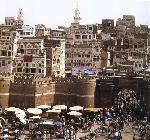 Almotamar Net
Almotamar Net - Sana’a is one of Yemen’s governates; it is situated at the center of the Yemeni plateau between two mountains in the Sana’a Basin. These mountains are the Nuqum and Ayban Mountains, and are on a height 2200 meters above sea level. Sana’a has a bright sun throughout the year except for a few weeks in the summer and spring, which are often cloudy. Generally, it is wonderfully fresh and moderate in summer and cold in winter. All districts and outskirts of Sana’a are mountainous.
Sana’a is considered one of the Islamic historical towns because it has the Old City of Sana’a that is a real miracle of old architecture. The old city of Sana’a is one of the most beautiful cities in Arabia and the Islamic World. The city is known by several names including the city of “ Sam ”. It is also said that the city was built by Shem, the son of Noah, following the flood.
It is also called “ Azal ” but the most common name is “Sana’a”, which is mentioned in a number of ancient Yemeni inscriptions, and means “the protected”.
In Sana’a there are more than 50 mosques, five with domes and many with minarets, the most important of which is the Great Mosque, built during the life of Prophet Mohammed and ordered by him in the Eighth Hegira year 630 AD.
There are many other mosques, which are not less beautiful or wonderful with respect to the style of minarets, domes and artistic embellishments. Sana’a has the highest mountain in Arabia; the mountain of the Prophet Shueib, which is 3766 meters above sea level.
It has also the most beautiful village Al-Hajara and the best quality of Yemeni coffee and grapes.
Tourist Area In Sana’a:
• Old Sana’a :
With its unique and marvelous architecture, Old Sana’a is in itself a living museum. The beauty of the city has inspired many writers, architects, poets, and even tourists. One cannot but imagine the talent and taste of the original architects of such a magnificent city.
The market is considered to be one of the significant components of the Arabic Islamic cities and the markets of old Sana’a are regarded as a living and rare example of this.
There are ten such markets, each specializing in a certain craft or merchandise such as the Cloth market, Grain market, Silk market, Raisins market, Cattle market, Thread market, Coffee Husk market, Caps market, Carpet market, Salt market, Brassware market, Silverware market, Firewood market, all of which are perfumed with the scents of the East.
There are about 15 steam baths in old Sana’a, which are a fundamental feature of the city, as baths are associated with cleanliness. It is said that the Persians introduced the baths.
Since 1984, the UNESCO has listed Old Sana’a among the international heritage cities as “World Heritage of Mankind”.
• Samsarah (Caravansaries):
In old Sana’a there were a number of inns (Khans), which were used to perform specific functions that were complementary to the business of the market, such as services of accommodation, storage, safekeeping of deposits and precious items.
Such facilities had a specific architectural style characterized by arches and terraces in the interior. The ground floor was usually used for camels and horses, there are even now samples of such brokerage inns. One of them is Al-Nahas Caravansary at the entrance of Salt Market, Bab Al-Yemen (Yemen Gate). This is now used as a center for the training of craftsmen and for the displaying of their products. Near by is another example called Samsarat Al-Mansour, which is presently a center artists whose medium is paint.
• Dhahr Valley :
Wadi Dhahr is located 14 km to the northwest of Sana’a and is considered to be the most important recreation area for the city of Sana’a. Here all kinds of fruit are grown. In the center of the Wadi perches Dar Al-Hajar (Rock Palace), a palace built on top of an enormous rock dating back to 1786 AD, and ordered by Imam Mansour Ali Bin Mehdi Abbas.
In addition, there are a number of ancient monuments scattered within the Wadi. Yemenis like to come with their families to this vantage point and gaze at the beautiful valley.
On Fridays tourists can witness traditional wedding dances in the plateau, visit the Palace and have small walking trips through the village.
• Al-Rawadha:
It is situated 8 km to the north of the city center. There is an ancient mosque in Al-Rawadha with artistically decorated minarets dating back to the 17th century. This mosque is called Imam Gasim Mosque. It also has rural clay houses made in the Sana’a style in addition to numerous vineyards.
Many people in Sana’a throughout history have gone to Al-Rawadha in order to relax, especially in the season of grape harvests. Another ancient landmark in this area is Al-Rawadha historical Palace, Which dates back to the early twentieth century and used to be one of the Palaces of Imam Yahya. It is now a hotel.
• Bait Baws:
A typical old village, Bait Baws is located 7 km to the south of Sana’a. Existing inscriptions found in the west of village show that the area was an important center in the ancient history of Yemen. The village is naturally fortified with only on entrance to the south.
• Haddah:
Lying about 8 kilometers from the city center, this region is continuously green because of its long trees of peanuts and other seasonal fruits. There are some old windmills, built during the Ottoman Empire’s rule of Yemen, which were driven by the force of water currents.
source: Yemen Times

